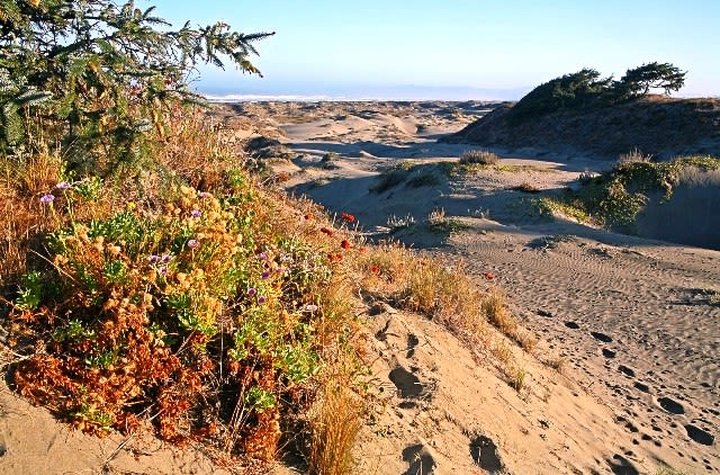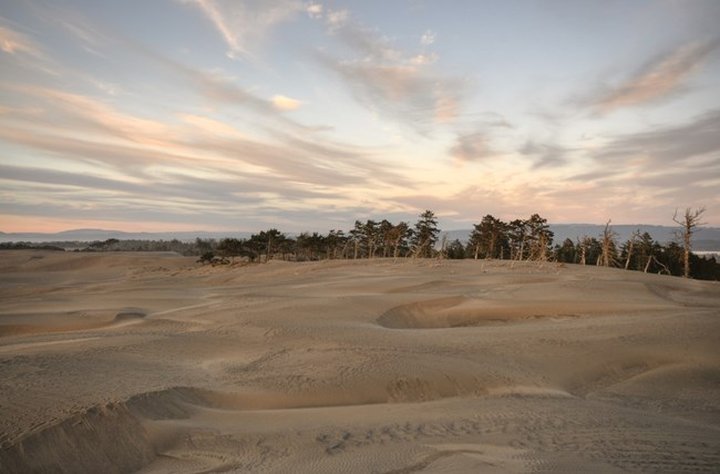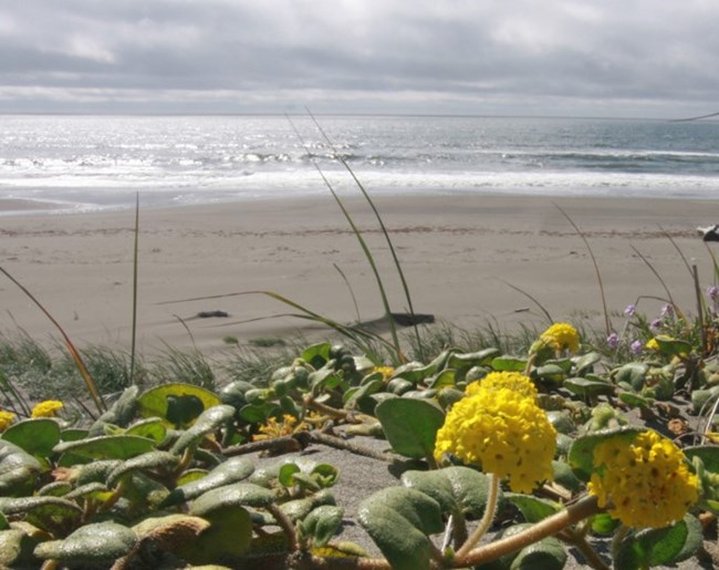
Lanphere Dunes. | Photo courtesy the Humboldt County Visitors Bureau.
###
On Tuesday, the final day of the Trump administration, Secretary of the Interior David L. Bernhardt honored the natural beauty and ecological value of Lanphere and Ma-le’l Dunes by designating them national natural landmarks.
The National Natural Landmarks Program, managed by the National Park Service, recognizes sites that have “outstanding biological and geological resources” while encouraging their conservation.
“It’s a way of recognizing truly special places that are of national significance,” said Mike Cipra, executive director of the nonprofit Friends of the Dunes.
The undulating sand mounds, woody swales and verdant wetlands of Lanphere and Ma-le’l Dunes, located on the Samoa Peninsula west of Arcata, are home to a remarkably diverse array of native flora. Coniferous and riparian forests rise above patches of pale green reindeer lichen, blooming sand verbena and Menzies wallflower, to name just a few species.
Cipra noted that with Friends of the Dunes’ recent acquisition of the 357-acre Samoa Dunes and Wetlands, there are now 1,600 contiguous acres of coastal dune habitat being preserved for conservation purposes.
Regarding the dunes’ designation as national natural landmarks, Cipra said, “I think it just reminds us that what we have here in Humboldt County, with these coastal dunes, is truly extraordinary and a treasure for all of us.”

The Lanphere Dunes and Ma-le’l Dunes are part of the Humboldt Bay National Wildlife Refuge, managed by the U.S. Fish and Wildlife Service, though the southern section of the Ma-le’l Dunes are on land owned by the federal Bureau of Land Management and managed cooperatively.
Jennifer Kalt, executive director of the nonprofit Humboldt Baykeeper, was excited by the designation news.
“We are really so lucky to have these places so close by and in such intact condition,” she said. “They’re really unique and amazing places and unlike anything else really I’ve ever seen anywhere.”
The designation may also make the landmark ecosystems eligible for more government funding to improve conservation, she said, adding, “We need to protect the places that have so much of their value still left.”

Dune field at Lanphere and Ma-le’l Dunes. Photo by Andrea Pickart, courtesy U.S. National Park Service.
###
It may seem like odd timing that this designation was made on President Donald Trump’s last day in office. In the announcement, Secretary Bernhardt said, “The Trump Administration has prioritized conservation since day one, and we have made historic progress to improve conservation stewardship nationwide.”
In fact, the Trump administration revoked or rolled back more than 100 environmental rules, with the Interior Department working “to open up more land for oil and gas leasing by limiting wildlife protections and weakening environmental requirements for projects,” according to an analysis by the New York Times.
Bernhardt, a former lobbyist for the oil and agriculture industries, has been widely accused of pushing policies that benefit his former clients. According to Outside magazine, he spent years fighting for the rollback of Endangered Species Act protections for the Delta Smelt in the Central Valley on behalf of Westlands Water District.
So how did this landmark designation come to fruition under his watch? Local environmental advocates credit the years, even decades of advocacy from stakeholders in the U.S. Fish and Wildlife Service, the National Park Service, the BLM and various Humboldt County environmental organizations.
In a Jan. 21 letter to Kalt at Humboldt Baykeeper announcing the designation, Ray Sauvajot, associate director of Natural Resource Stewardship & Science at the Interior Department, sang the praises of the dunes, noting that they “contain virtually all the species of vascular plants typical of dune systems in northern California and southern Oregon.”
He added, “This 834-acre site is home to several rare species, including one of the best remaining populations of the endangered Menzies wallflower (Erysimum menziesii) and beach tidy-tips (Layia carnosa).”
The letter says designation as a national natural landmark (of which there are now 602) is intended “to encourage and support conservation of these nationally significant sites.”
The Ma-le’l Dunes are open to the public every day from sunrise to sunset. To visit the Lanphere Dunes you’ll need a permit, or you can attend a guided tour by contacting Friends of the Dunes at (707) 444-1397. More info is available on the organization’s website.

Yellow sand verbena along the beach at Lanphere and Ma-le’l Dunes. Photo by Andrea Pickart, courtesy U.S. National Park Service.
CLICK TO MANAGE